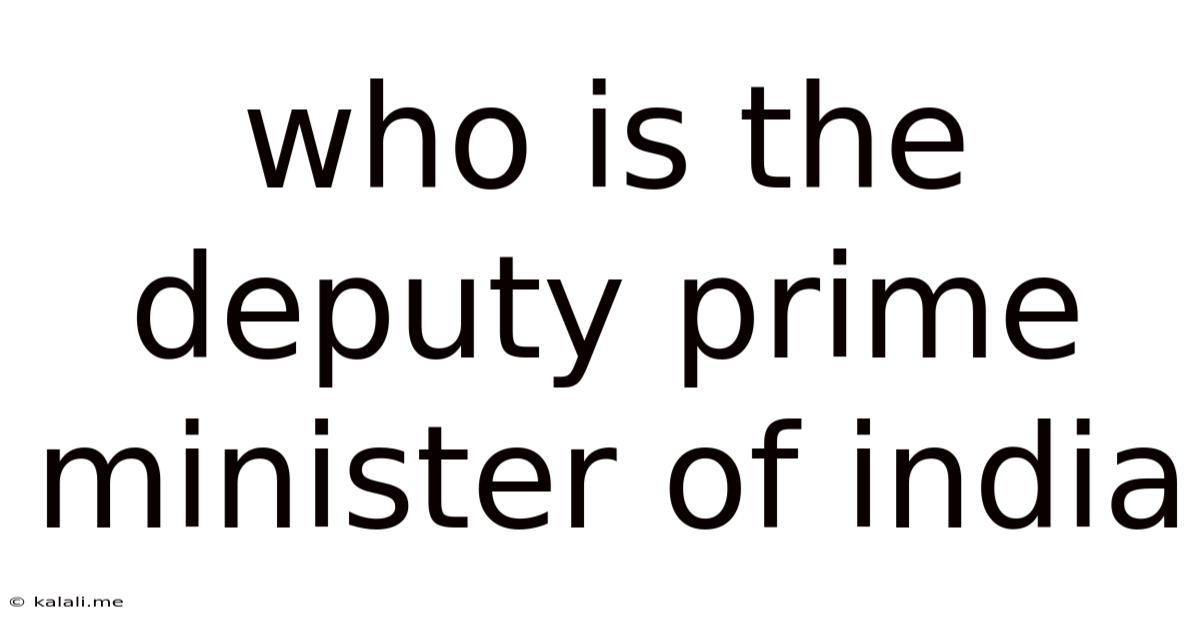Who Is The Deputy Prime Minister Of India
Kalali
Jun 11, 2025 · 3 min read

Table of Contents
Who is the Deputy Prime Minister of India? Understanding India's Governance Structure
India, the world's largest democracy, operates under a parliamentary system. While the Prime Minister holds the highest executive office, the question of a Deputy Prime Minister is often raised. This article clarifies the role and explores the historical context of this position in India's governance. Understanding the structure helps clarify why the position isn't always filled.
The Absence of a Formal Deputy Prime Minister Role
Unlike some other parliamentary systems, India doesn't have a constitutionally mandated position of Deputy Prime Minister. There's no specific provision outlining the powers and responsibilities of such a role. While several individuals have held the title of "Deputy Prime Minister" in the past, it was always a designation conferred by the Prime Minister, not a fixed position within the government's structure. This means the title holds no inherent power beyond what the Prime Minister chooses to grant.
Historical Context: When Deputy Prime Ministers Served
Several prominent figures have served in roles akin to Deputy Prime Ministers, holding significant influence and responsibility. These appointments were often made strategically, based on factors like political expediency and the need for experienced leadership within the cabinet. Notable examples include:
-
Sardar Vallabhbhai Patel: Often regarded as the country's first Deputy Prime Minister (though never formally titled as such), Patel played a crucial role in the integration of princely states into the Indian Union. His influence and experience were invaluable to the nascent government.
-
Morarji Desai: He served as Deputy Prime Minister under Indira Gandhi. His experience and prominence within the Congress party were key factors in his appointment.
-
Charan Singh: He also served as Deputy Prime Minister and later briefly as Prime Minister. His appointment highlighted the political dynamics of the era.
The Current Scenario: Why No Deputy Prime Minister?
Currently, India does not have a Deputy Prime Minister. The Prime Minister, Narendra Modi, heads a council of ministers, where individual ministers oversee various portfolios. This structure allows the Prime Minister to distribute responsibilities and delegate power as needed, effectively managing the executive branch. The absence of a formal Deputy Prime Minister doesn't indicate any weakening of the government; rather, it reflects a chosen administrative structure.
The Role of Other Key Ministers
While there's no Deputy Prime Minister, several ministers hold significant influence and responsibility within the government. These individuals often act as key advisors to the Prime Minister, handling critical issues and representing the government in various capacities. Their specific roles and responsibilities are clearly defined within their ministerial portfolios.
Conclusion: A Flexible Approach to Governance
India's flexible approach to the Deputy Prime Minister's role demonstrates adaptability in governance. The absence of a fixed position doesn't hinder the efficiency of the government. The Prime Minister retains the prerogative to delegate power and responsibility to key ministers, ensuring the smooth functioning of the executive branch. The focus remains on effective governance rather than adhering rigidly to a particular hierarchical structure.
Latest Posts
Latest Posts
-
How Many Crackers In A Sleeve Of Saltines
Jul 01, 2025
-
How Many Years Are In 48 Months
Jul 01, 2025
-
What Grade Is A 12 Out Of 15
Jul 01, 2025
-
The Opposite Of The Opposite Of Inexact Is
Jul 01, 2025
-
9am To 1pm Is How Many Hours
Jul 01, 2025
Related Post
Thank you for visiting our website which covers about Who Is The Deputy Prime Minister Of India . We hope the information provided has been useful to you. Feel free to contact us if you have any questions or need further assistance. See you next time and don't miss to bookmark.